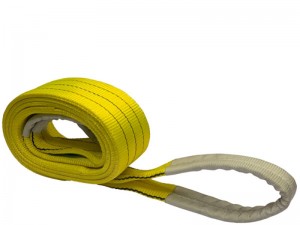Synthetic fiber lifting belt is a kind of high strength and low extension lifting belt. Originated in Europe and the United States developed, now used in the field of industrial lifting has 60 years of history. Its superior performance is favored by the majority of users.
The synthetic fiber hoisting belt mainly solves the technical problem of metal material rigid sling, such as steel wire rope, which is easy to scratch the cargo in the hoisting process.
Synthetic fiber lifting belt belongs to non-metallic material lifting appliances. Non-metallic material hoisting appliance is also known as flexible hoisting sling in China. Among all lifting belt types, flexible lifting belt is especially famous for such performance characteristics.
Compared with metal materials hoisting appliances, synthetic fiber hoisting belt why will have unique advantages? The research shows that the tensile strength and elongation of the synthetic fiber lifting belt are close to or reach the performance of the steel wire rope, and there will be no scratches and lifting traces when lifting, so as to meet the precision requirements and appearance quality of the product.
In terms OF HOISTING BELT SPECIFICATIONS, in the existing development of hoisting belt pedigree, the specification of synthetic fiber hoisting belt ranges from several hundred kilograms to several thousand kilograms.
The successful development of synthetic fiber hoisting belt fills the gap in hoisting history at home and abroad, improves hoisting efficiency and promotes economic development.
The lifting belt we use has a standard restriction, Lifting Sling Belt factory often people always ignore the ribbon part in the bearing process of the width of the change, the width of the ribbon change is also a standard, the more detailed part can see a lifting belt manufacturer is professional. Ribbon width change is difficult to be observed with the naked eye in use, lifting ribbon is qualified? Is it up to standard? You can’t see it until you test it experimentally. First we should first understand the hoisting belt webbing width of the standard is what.
Hoisting ribbon width standard: ribbon normal width is not more than 100mm, if any width measurement value decreases more than 10% of the normal width, the ribbon is disqualified. Similarly, when the normal width of the webbing is greater than 100mm, if any width measurement value decreases more than 12% of the normal width, the webbing is disqualified.
Know the standard below the detailed introduction, through the seven steps of the experimental method to know the ribbon under the stress of the change value.Lifting Sling Belt factory

Step: Put a sample of sewing webbing parts on the test machine, without applying any load, so that the webbing forms a loose catenary.Lifting Sling Belt factory
Step 2: Make a middle mark on the surface of the webbing, which is perpendicular to the longitudinal axis and at the midpoint of the webbing. Make a division mark on both sides of the middle mark, and the two marks should be respectively between the middle mark and the bearing point on both sides of the ribbon, and divide the braided belt into four parts of equal width.
Step 3: Measure the width of the webband at each mark (midpoint and two division marks), measure it in millimeters and record it as W1.
Step 4: Then apply a bearing capacity equal to 2 times the ultimate working load on the webbing.
Step 5: Maintain the applied force of 2 times the limit working load, then measure the width of the webbing at each mark, measure the value to mm, and record it as W2.
Step 6: Calculation formula. The size change of the width at the three positions is expressed by percentage, and the calculation formula is [(W2-W1)/W1] ×.
The seventh step: according to the test measured data can easily judge whether the lifting belt is qualified.
Post time: Sep-08-2022
